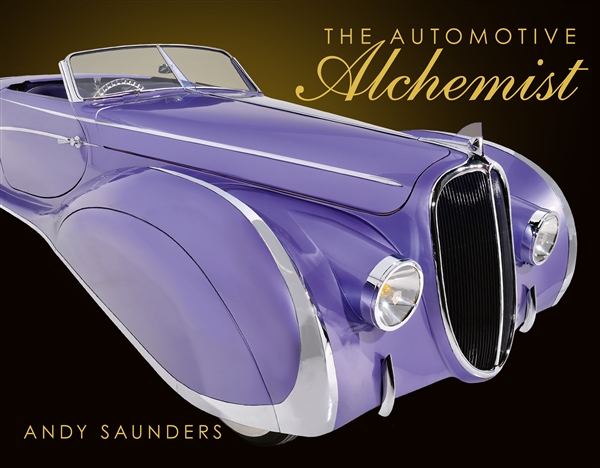
Andy Saunders’ ‘Automotive Alchemist ’ is a roller-coaster ride through the highs and lows of this charismatic man’s life. From the early years of learning the basic skills of cutting and shaping metal then painting and airbrushing, to his mature creations, restorations and the inherent genius of his designs. Andy welcomes us into his workshop and his head: not afraid to express his emotions, as he deconstructs and then rebuilds each vehicle, he lays bare his motivations, inspirations, influences, and passions. Intertwined in the narrative is the work involved in the creation of 60 cars, described here with many detailed photographs.
Forty-two of Andy’s creations now reside in museums and private collections across the globe but the most unusual fate is that of Flat Out, the Guinness Book of Records acclaimed Lowest Car in the World, which is now a coffee table in the foyer of a huge Californian corporation.
The book is not a technical ‘how to create wild custom cars’ manual. Rather it is a celebration of Andy’s joy of creation and his design genius, though tempered by personal traumas and losses. He has, on many occasions, been referred to as the British George Barris, the American “King of Kustomizers.” Unlike many biographies, this book engages the reader with its honesty and humour.
Andy Saunders grew up in Poole on the south coast of England and developed an early relationship with the building and customising of cars. His first project was finished before he was old enough to hold a British driving license.
Since that first project, his journey to become Britain’s leading and most recognisable ‘Car Artist’ has evolved. With his painstaking attention to detail and his knowledge of the styling masters from bygone eras, his creations have always been unique and, occasionally, controversial.
Never shy of turning his ideas into reality or taking unexpected opportunities to fruition, Andy has, on occasions, thrown away the accepted rule book and created some truly amazing vehicles: making a Citroën CX into a road-legal alien craft; turning Ford’s 1958 X-2000 ‘car of the future’ model into a full-sized reality and creating a Cord coupe that the factory would have been proud to call their own.
Andy has three Guinness Book of Records certifications: twice for the ‘lowest car in the world’ and once for the ‘lowest van in the world’ which remains unbeaten and has been approached by film companies and undertaken commissions for major car manufacturers. But mostly he builds whatever has inspired his creative juices from lowriders, Incantation, to shortened Minis, Mini Ha Ha; from restyling a Bentley Mulsanne, which was acclaimed by the Rolls-Royce and Bentley Owners Club as “the most beautiful coachbuilt Bentley to have been built since WWII”, to a 2CV inspired by Picasso – Picasso’s Citroën; and from his drivable version of Bertone’s Lancia Stratos Zero to his Art Deco creation of a rare 1939 Peugeot, Metropolis, inspired by Fritz Lang’s 1927 masterpiece of the same name.
During the past four decades Andy has restored Cord, Pontiac and Rolls Royce vehicles. Rescued and restored the unique and much-maligned 1957 Aurora Safety Sedan and realised an affinity with the great designer Alex Tremulis. Andy’s creations have appeared in exhibitions, on television and in magazines as far afield as Australia, Korea, America, the UK and Europe and many of his vehicles nowadays reside in museums and collections from California to Japan and from Europe to the Middle East.
And so to his latest masterpiece, Déjà: inspired by a 1930’s popular French girls name, some body panels he didn’t want or need and the pinnacle of French coachbuilding, Andy has created this Delahaye, a hand-built steel roadster. This beautiful cross between Joseph Figoni’s 165s and Jacques Saoutchik’s 175 somehow appears to be some eighty-five years late for her debut at the Paris Salon de l’Automobile.
- 464 pages
- Hard cover with dust jacket
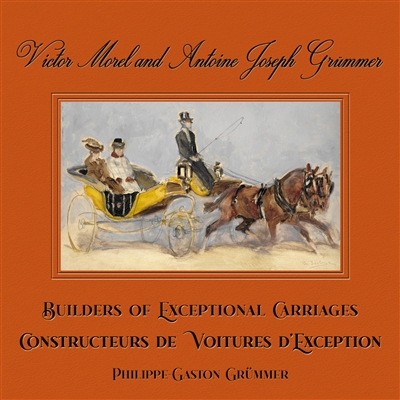
Maison V. Morel was founded in 1845 by Victor Jacques Morel (1814-1879) and became one of the most important Parisian coachbuilders during the second half of the 19th century at a time when France dominated the industry, replacing England as leaders in the field. Antoine-Joseph Grümmer (1834-1909) succeeded Jacques Morel in 1879 and the company became known as Société J. Grümmer, formerly Maison Morel.
This book introduces the reader to many previously unpublished documents and illustrations of exceptional carriages and cars that were the pride of their owners both in France and overseas and describes their importance in the day-to-day life of Parisian high society. Mention is also made of the many high-quality suppliers who contributed to the manufacture of the carriages including Hermès, Louis Vuitton, and Boyriven.
The book is written in both English and French.
-
- 378 images / 139 drawings
- Dual-language (English and French)
- 290mm x 219mm, landscape
- Hard cover
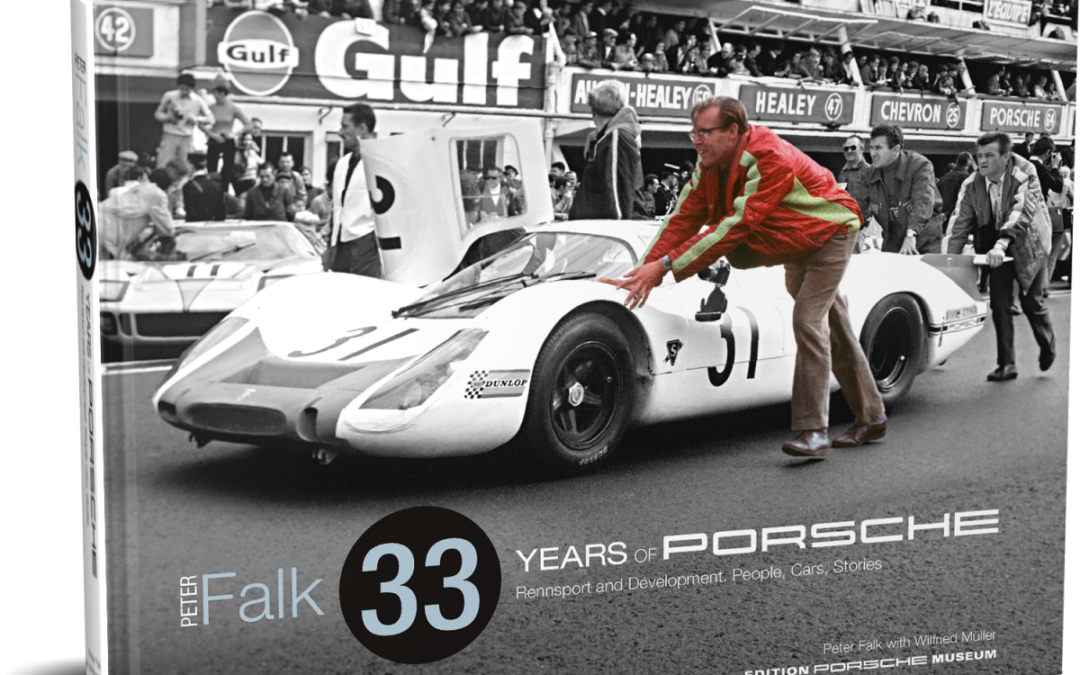
This edition of the book is limited to only 150 numbered copies, contains a hand signature of Peter Falk and comes in a luxury linen slip case.
Peter Falk and Porsche, 33 years of passion and devotion: As their race director and one of the leading figures in their experimental department, Peter Falk contributed significantly to the character of the sports cars from Stuttgart-Zuffenhausen – both on the race track and on the road.
From the first 901 right through to the very last air-cooled Type 993, every Porsche 911 bears the signature of Peter Falk. He joined the company in 1959 and quickly rose through the ranks to head various testing departments. In the mid-sixties, Falk also took over the tactical and technical leadership of the factory’s “Rennsport” team. In 1981, he was appointed as race director and led Porsche throughout its most successful era of competition. “His” team won at Le Mans, became World Sports Car Champions, conquered the Paris-Dakar Rally, and was victorious in Formula 1 with the TAG Turbo engine.
In this book, Peter Falk tells of his years with Porsche. A highly respected person in the world of engineering, he relates how it all began at Porsche – when race drivers and engineers huddled together in a shepherd’s hut at Weissach to discuss suspensions, what the Porsche crew experienced during endless testing adventures in both the Arctic Circle and the Sahara, how the race cars at Le Mans roared to the start over country roads, and how a test drive with a Porsche 908 almost cost him his life. He shares his views on every Porsche race car, from the 904 Carrera GTS to the 962C, and describes the race drivers who competed during his reign: Hans Herrmann, Jacky Ickx, Vic Elford, Derek Bell, Hans-Joachim Stuck and Jochen Mass to name just a few. Falk provides a good, long look into the inner workings of Porsche.
Peter Falk shared his personal Porsche stories and fascinating insights with the author Wilfried Müller. The images in this book come from Peter Falk’s private collection, from the Porsche Historical Archive in Stuttgart-Zuffenhausen, and from the vast cache at McKlein Photography. Along with the contributions from former colleagues and race drivers, these images and stories give an in-depth portrayal of Peter Falk’s 33 years with Porsche.
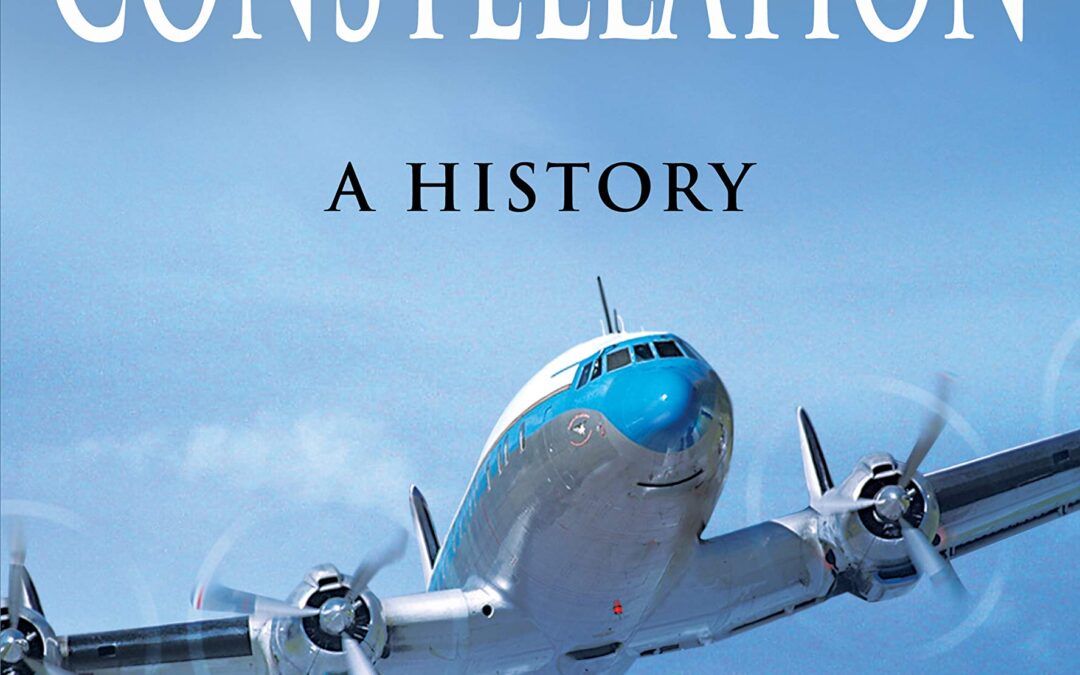
Clarence ‘Kelly’ Johnson’s design for the Lockheed Constellation, known affectionately as the ‘Connie’, produced one of the world’s most iconic airliners.
Lockheed had been working on the L-044 Excalibur, a four-engine, pressurized airliner, since 1937. In 1939, Trans World Airlines, at the instigation of major stockholder Howard Hughes, requested a 40-passenger transcontinental aircraft with a range of 3,500 miles, well beyond the capabilities of the Excalibur design. TWA’s requirements led to the L-049 Constellation, designed by Lockheed engineers including Kelly Johnson and Hall Hibbard.
Between 1943 and 1958, Lockheed built 856 Constellations in numerous models at its Burbank, California, factory – all with the same distinctive and immediately recognizable triple-tail design and dolphin-shaped fuselage.
The Constellation was used as a civil airliner and as a military and civilian air transport, seeing service in the Berlin and the Biafran airlifts. Three of them served as the presidential aircraft for Dwight D. Eisenhower. After the Second World War, TWA’s transatlantic service began on 6 February 1946 with a New York-Paris flight in a Constellation. Then, on 17 June 1947, Pan Am opened the first-ever scheduled round-the-world service with their L-749 Clipper America.
In this revealing insight into the Lockheed Constellation, the renowned aviation historian Graham M. Simons examines its design, development and service, both military and civil. In doing so, he reveals the story of a design which, as the first pressurized airliner in widespread use, helped to usher in affordable and comfortable air travel around the world.
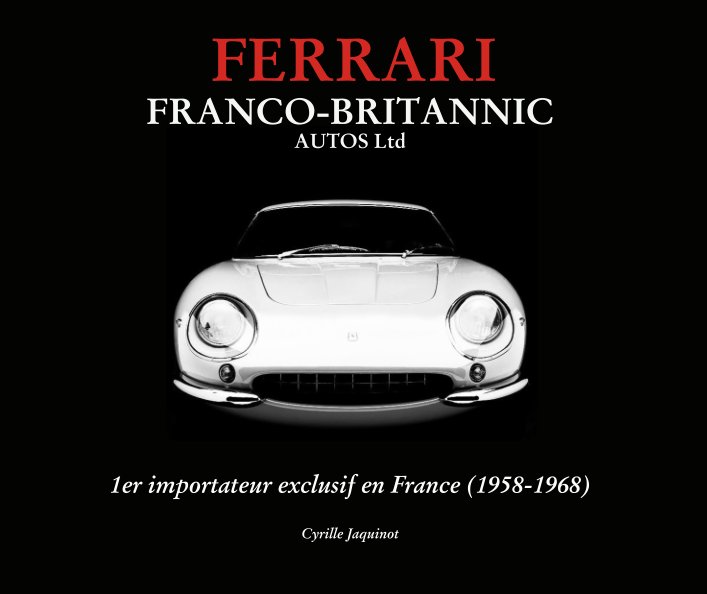
This book on a theme never before addressed is a tribute to the Sleator family, Franco-British family, as well as to all employees, partners, friends and customers of the Franco-Britannic Autos Ltd who, during these 10 years of the import, have promoted the extraordinary image of Ferrari in France…
Certainly the most beautiful Ferrari period in France !
The Franco-Britannic Autos Ltd, thanks to Walter and his son Donald Sleator, imported the most beautiful cars in the world on French soil from 1933 to 1989 for their most demanding customers.
Exclusive importer since 1933 in Paris of the two prestigious British brands Rolls-Royce and Bentley, then importer Rover (and Land Rover), Franco-Britannic Autos Ltd from the autumn of 1958 becomes the first exclusive Ferrari importer in France.
The Franco-Britannic Autos Ltd has experienced this new generation of buyers, the “Nouvelle Vague” as sung in one of his songs a certain Richard Anthony, young film actors, writers, and other artists, businessmen, industrialists … all needed and wanted to stand out by associating their image with that of exceptional automobiles and more particularly Ferrari.
Celebrities such as Jean-Paul Belmondo, Yves Montand, Lino Ventura, Françoise Sagan, Roger Vadim, Mylène Demongeot, Johnny Hallyday, Alain Delon, Claude Francois and many other stars were at one time clients of the Franco-Britannic Autos Ltd. The art of owning a road Ferrari, a very dynamic image, is considered a symbol of professional and social success.
The first Ferrari commercials in France by the FBA Ltd, our French stars of the “Yé-Yé” era, all the Paris Motor Shows, All Ferraris destined for the Marshall during the 24 Hours of Le Mans, piloted by Donald Sleator, then an official pilot until 1967.
There will also be a great tribute to Pierre Noblet with unpublished documents, Sylvain Garant…
Preface and anecdotes of Donald Sleator.

The inspiring, heart-pumping true story of soldiers turned cyclists and the historic 1919 Tour de France that helped to restore a war-torn country and its people.
On June 29, 1919, one day after the Treaty of Versailles brought about the end of World War I, nearly seventy cyclists embarked on the thirteenth Tour de France. From Paris, the war-weary men rode down the western coast on a race that would trace the country’s border, through seaside towns and mountains to the ghostly western front. Traversing a cratered postwar landscape, the cyclists faced near-impossible odds and the psychological scars of war. Most of the athletes had arrived straight from the front, where so many fellow countrymen had suffered or died. The cyclists’ perseverance and tolerance for pain would be tested in a grueling, monthlong competition.
An inspiring true story of human endurance, Sprinting Through No Man’s Land explores how the cyclists united a country that had been torn apart by unprecedented desolation and tragedy. It shows how devastated countrymen and women can come together to celebrate the adventure of a lifetime and discover renewed fortitude, purpose, and national identity in the streets of their towns.
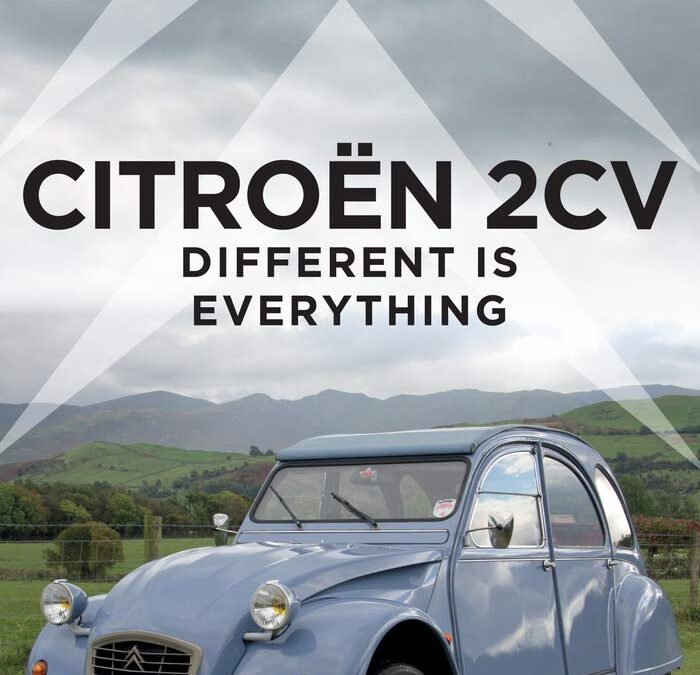
In this readable and informative book, motoring expert Malcolm Bobbit tells the story of one of the most iconic cars in motoring history. Designed as affordable and practical transport for French farmers traveling on either bad roads or plowed fields, it also found its way into the fashionable quarters of Paris. The book shows how designers successfully achieved the specification for rugged and utilitarian design suitable for times of austerity while at the same time producing a truly classless car. The author explains the history of the car, conceived when Citroen was owned by the Michelin tire company, and how the idea evolved. He covers the ingenious design aspects of the car, including the corrugated metal bonnet, hammock seats, push-pull gear lever, and twin-cylinder air-cooled engine. Such was the success of the 2CV that it spawned variants such as the Dyane, Ami 6 and Ami 8, and the British-built Bijou, all of which are covered in the book. Illustrated with a unique collection of high-quality photographs and written by an authority on Citroen cars, this concise book tells you all you need to know about the famous 2CV.

Design and the Bristol Car contains a description of the evolution of draughting techniques from the shipbuilding days, through aviation design and car design into the CAD-era, interspersed with the life story of Dudley Hobbs, chief designer at Bristol Cars from 1946 to 1976.
The second part of the book contains: Fascinating reports from the Bristol Aeroplane Company visits (by Dudley Hobbs) to Geneva, Lugano and Milan, the Paris and Geneva Motorshows and Carrozzeria Touring / A critical appraisal of the work of Dudley Hobbs by a current car designer / The pre-war history of the BMW 326, 327 and 328, which might be described as the first Bristols.

Following the Lambda of 1922, a car at the forefront of the world of automotive design holding a number of world patents, the Dilambda was presented at the Paris Motor Show in 1929, a car of absolute excellence in the best tradition of Italian design. There were three series of cars from the best coachbuilders of the time. Among these the English firm Carlton Carriage Company created the car which is the subject of this monograph, BS, Blue Shadow of 1930. The volume traces the history of this specific model and above all the meticulous restoration that brought it back to the ancient splendor.
A beautiful book dedicated to a car of great charm and history.
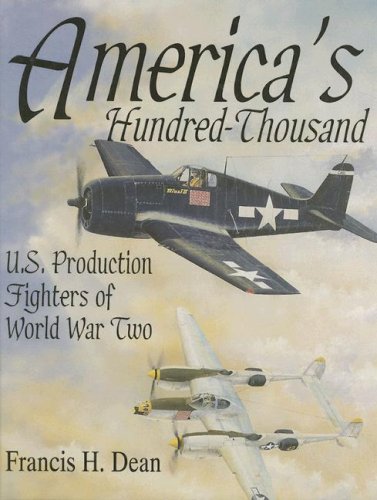
America’s Hundred Thousand covers in detail the eleven U.S. fighter aircraft types produced just before and during World War II – with a combined production total of just over 100,000 aircraft. Covered are the Army Lockheed P-38 Lightning, P-39 Airacobra, Curtiss P-40 Tomahawk/Kittyhawk/Warhawk, P-47 Thunderbolt, North American P-51 Mustang, Northrop P-61 Black Widow, and the Navy F2A – Buffalo, F4F – Wildcat, F4U – Corsair, and F6F – Hellcat fighters. The text is supplemented by more than 650 photographs, and 200 tables and graphs. Fighter production figures are also included. After an introduction of each type, a heavily illustrated overview of earlier inter-war production from 1920-on, along with a discussion and illustration of wartime experimental types, is provided. A lengthy section considering several technical factors affecting fighter performance follows. These include engine models, supercharger types, propellers, aerodynamic thrust, lift and drag, aircraft weight, balance, stability and control, and armament. America’s Hundred Thousand also provides details of each U.S. World War II production fighter in terms of models and changes, numbers produced, and major engine and aircraft performance aspects – in tabular and graphical form – details of weights, discussion of handling qualities and general comments, along with detailed descriptions containing many illustrations of aircraft structures and systems showing the technology of that time. In addition a comprehensive week-to-week and month-to-month chronology of development and wartime combat operational life for each fighter is provided, including many photos. This study concludes with comparisons of the eleven types in terms of program milestones, aircraft drag, power available at various altitudes, speed, climb, rolling and turning, acceleration, and diving performance, as well as general evaluations by World War II pilots.
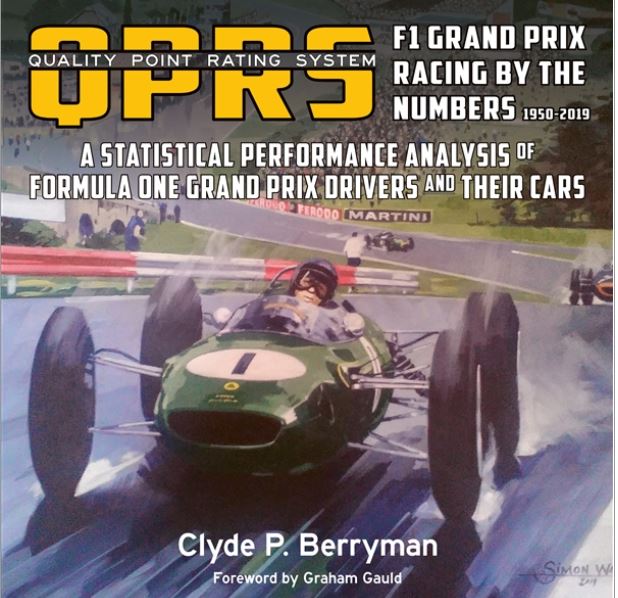
AVAILABLE APRIL 2021
WAS IT THE DRIVER, OR WAS IT THE CAR? That seems to be the age old, eternal question when motor racing enthusiasts gather to discuss the relative merits of Formula One Grand Prix drivers. Author Clyde Berryman devised a mathematical formula rating system, the Quality Point Rating System (QPRS), to objectively analyze and rate driver and car performances separately and came up with his own ranking system which was first featured in the July 1999 issue of F1 RACING Magazine.
This book is the updated and comprehensive QPRS study of Formula One Grand Prix racing drivers and cars from 1950 to 2019. It has an introductory section which discusses the principles behind the rating system and the major changes which have taken place over the evolution of F1, which often make direct comparisons quite difficult. Every chapter covers each decade with a short summary of the racing which took place, a QPRS ranking of the 10 best drivers and 10 best cars of the decade, and annual tables which provide the season calendar and the historical championship points, and the QPRS driver and car ratings for each year.
There are some all-time ranking tables and other pertinent analyses contained in summaries at the end of the book. In addition to maps of the many circuits used throughout F1 history, this massive 500-plus page volume features the exceptional artwork of some of the leading contemporary motor racing artists in the world.
- Hard cover with dust jacket
- 286 x 229mm (landscape)
- 528 pages
- More than 173 original art and 77 illustrated track maps
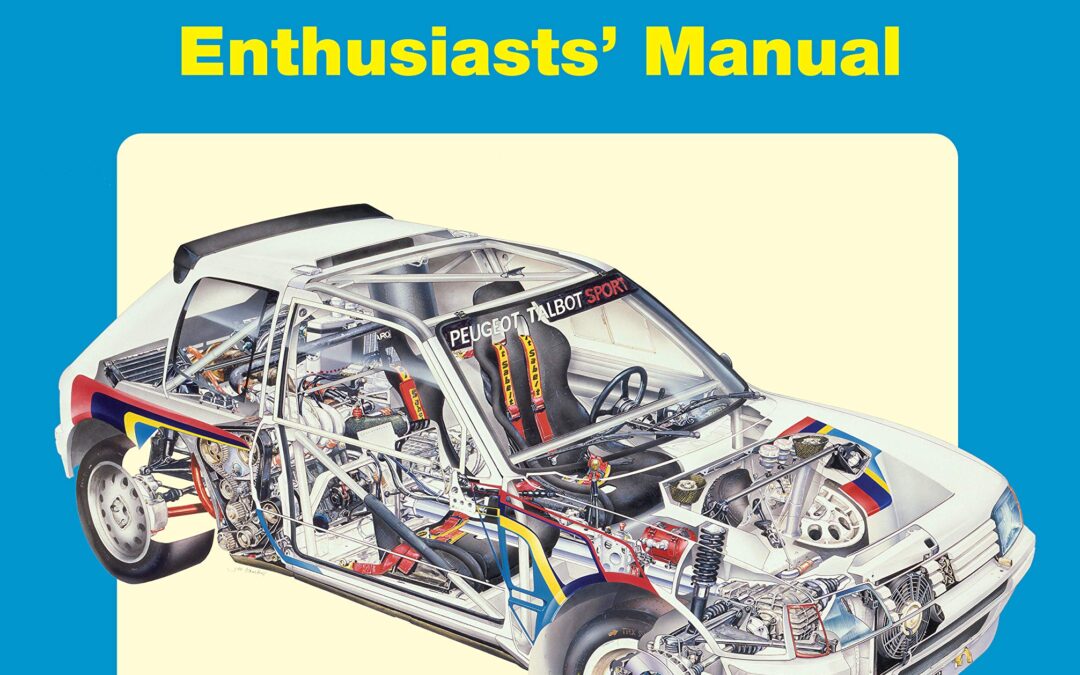
The Peugeot 205 T16 is the legendary Group B turbocharged four-wheel-drive rally car produced by Peugeot between 1984 and 1986. Between 1984 and 1986, 205 T16s won 16 World Championship rallies in the hands of Ari Vatanen, Timo Salonen, Juha Kankkunen and Bruno Saby, and lifted both the manufacturers’ and drivers’ titles in 1985 and 1986 in the hands of Timon Salonen and Juha Kankkunen, respectively, against strong opposition from Audi, Lancia, Ford and Austin-Rover.
The car was used to extraordinary effect by Peugeot as a marketing tool for the 205 road car, and the project lifted Peugeot to become a mainstream manufacturer to rival the established brands worldwide. The original 205 T16 appeared on the rally stages in 1984, while the revised ‘E2’ was introduced partway through 1985. The ‘E2’ incorporated various revisions raising power output to 550bhp.
After the cancellation of Group B at the end of 1986, Peugeot modified three 205 T16 cars to compete in the famous Pikes Peak Hillclimb, and later cars were modified to compete in the Paris-Dakar rally, winning in 1987 and 1988. The car also formed the basis of the ‘405 T16’, which won the Paris-Daker for Peugeot in 1989 and 1990.
Today, the appearance of 205 T16s is always eagerly anticipated at historic rally events, and motorsport retrospectives such as the Goodwood Festival of Speed.
Peugeot 205 T16 Group B Rally Car Enthusiast’s Manual chronicles the design, anatomy and operation of the 205 T16, with input from many of the drivers and engineers involved.
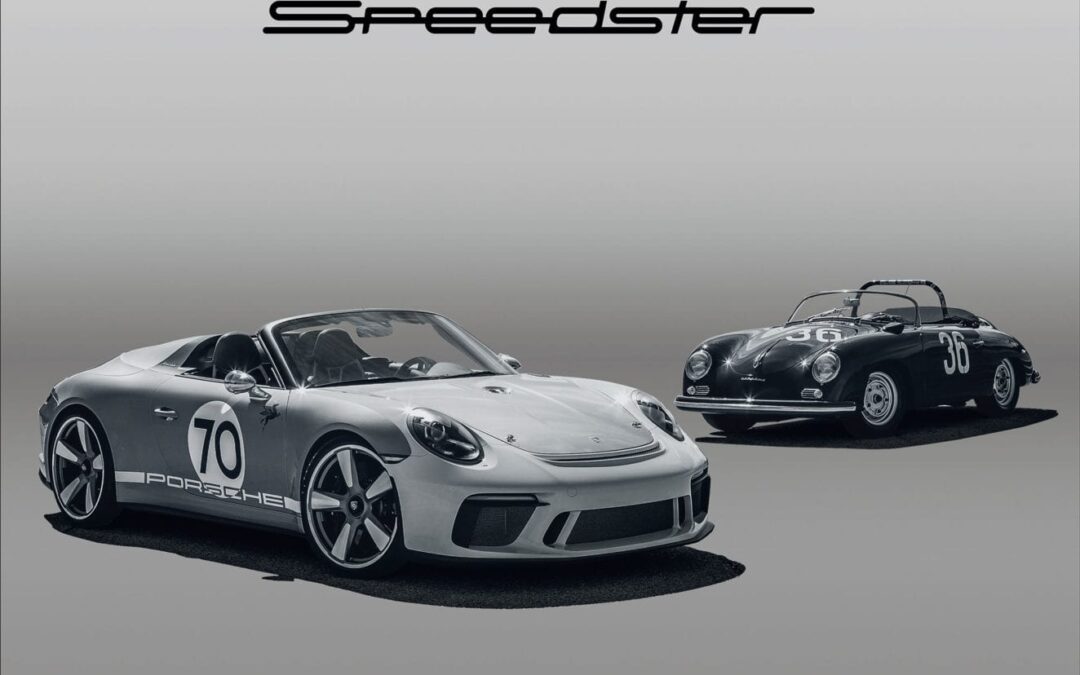
The fact that Porsche owes a not insignificant part of its legendary reputation to the Speedster makes this synoptic consideration of its entire history all the more interesting! It begins with a meeting between Professor Ferdinand Porsche and US importer Max Hoffman at the Paris Motor Show in 1950 and ends with the most recent Porsche Speedster in 2020.
The book entitled “Porsche Speedster Legends 1954-2020” will be published as a limited edition of 1954 books on 28 August 2020. This volume pays homage to the most beautiful and sought-after Porsche models of all time.
Special features in this book
- Detailed purchasing advice and price trends
- Extensive information about special models
- Unpublished documents and photographs for Speedster history
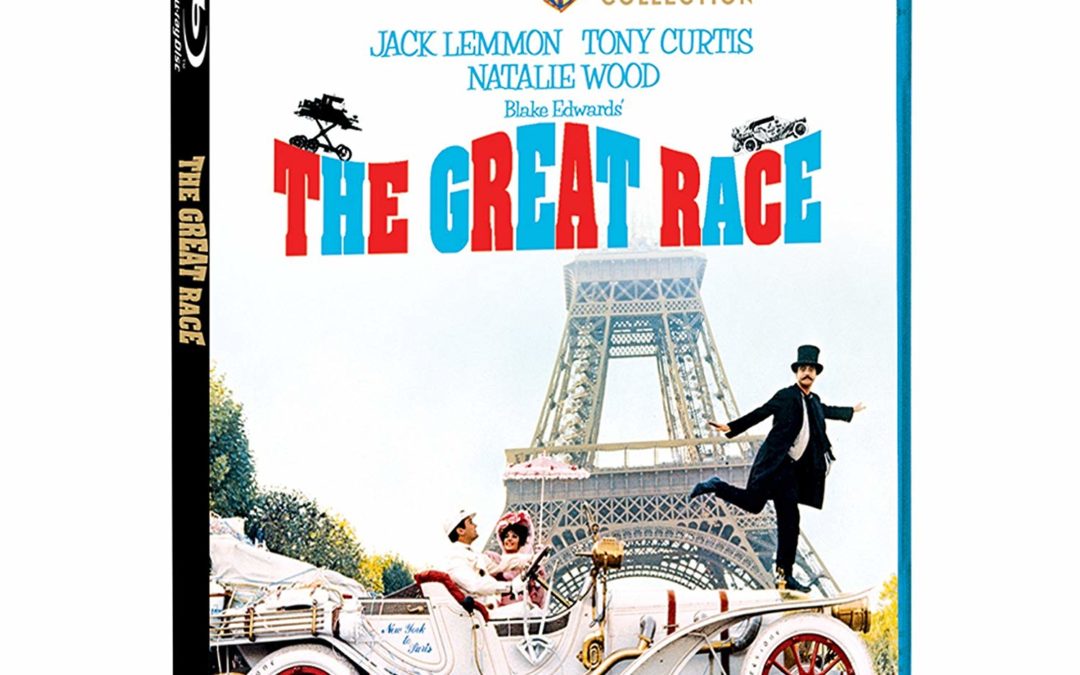
Tony Curtis stars as The Great Leslie, a hero among heroes whose purity of heart is manifested by his spotlessly white wardrobe. Leslie’s great rival, played by Jack Lemmon, is Professor Fate, a scowling, mustachioed, top-hatted, black-garbed villain. Long envious of Leslie’s record-setting accomplishments with airships and sea craft, Professor Fate schemes to win a 22,000-mile auto race from New York City to Paris by whatever insidious means possible. The problem is that Fate is his own worst enemy: each of his plans to remove Leslie from the running (and from the face of the earth) backfires. Leslie’s own cross to bear is suffragette Maggie Dubois (Natalie Wood), who also hopes to win the contest and thus strike a blow for feminism. The race takes all three contestants to the Wild West, the frozen wastes of Alaska, and, in the longest sequence, the mythical European kingdom of Carpania. This last-named country is the setting for a wild Prisoner of Zenda spoof involving Professor Fate and his look-alike, the foppish Carpanian king. When Leslie and Fate approach the finish line at the Eiffel Tower, Leslie deliberately loses to prove his love for Maggie. Professor Fate cannot stand winning under these circumstances, thus he demands that he and Leslie race back to New York.
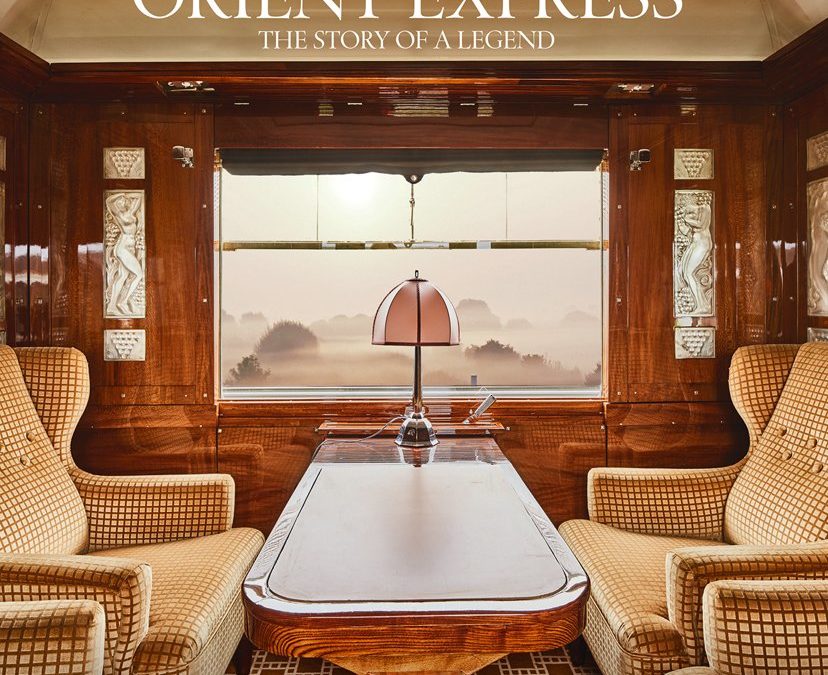
This beautifully illustrated book captures the history, the legends and the unique style of the most famous train on earth: The Orient Express
• With never-before-seen archival material
• With a preface by Sir Kenneth Branagh
“The Orient Express, in the collective imagination, embodies the golden age of travel. The fabrics, the silverware, the woodwork; their evocative fragrance… all contribute to this particular atmosphere, created by the best craftsmen of the time. The experience on board is absolutely unique…” – Sir Kenneth Branagh, from the foreword
The first train to connect Paris to Constantinople – the gateway to the Orient and epitome of all its associated desires and fantasies – the Orient Express was an immediate success. Quickly nicknamed ‘the king of trains, the train of kings’, it had already become a legend in its own time. This unique train and its celebrated passengers (both real and fictional) have become one of the great cultural icons of our times and have helped to create a limitless source of stories and fantasies to feed our imaginations. It’s a story told here through fabulous new photographs of the restoration workshops where the historic train carriages are being brought back to life, through archive photos of famous and exotic destinations, and portraits of the most famous passengers who were lucky enough to climb aboard.

Getting a Rover K-Series engine properly up and running can be a difficult task, but the result is always worthwhile. Rover K-Series Engine – Maintenance, Repair and Modification is a practical guide to keeping these unique engines in fine working order. The most well-known issue with the K-Series is the head gasket, and this book identifies common faults, before giving practical advice on how best to solve them. Step-by-step guidance on long-term engine maintenance is provided, in addition to the improvements required to prevent further problems. A K-Series engine is stripped down to examine its clever and interesting structure, and is rebuilt with improvements. Authors of over twenty automotive books, Iain Ayre and Rob Hawkins have combined their knowledge to bring you this book on the Rover K-Series engine. Topics covered include the history of the K-Series; common faults and solutions; full strip down and rebuild; the Rover KV6; modifications for power and reliability; electronics and programming and comparisons with similar engine options.

This new title in Veloce’s Enthusiast’s Restoration Manual series provides professional but easy-to-follow know-how on how to restore, improve and maintain your classic car’s suspension, steering and wheels. This book will familiarize you with the components of your car’s suspension and steering systems and their construction, it also takes a detailed look at refurbishing wheels and the choice of tires. The relevant restoration techniques are fully explained and illustrated with detailed step-by-step photography. How to Restore & Improve Classic Car Suspension, Steering & Wheels is based on articles from Europe’s leading classic car magazine, Oldtimer Market.
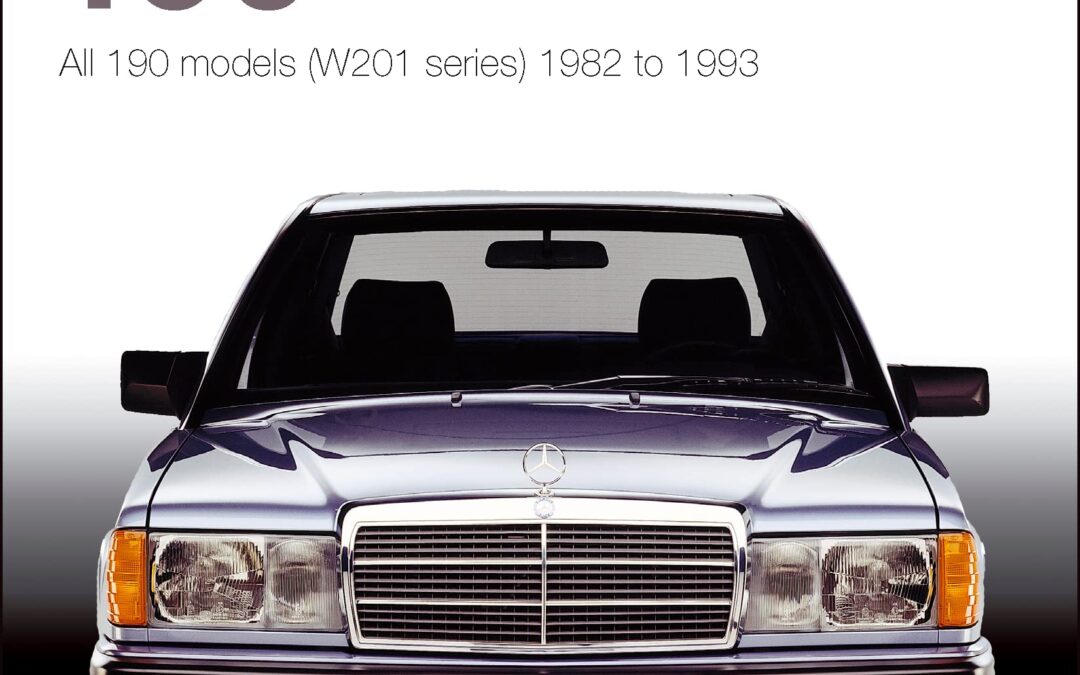
The 190 (W 201) was a landmark car for Mercedes-Benz: the predecessor to today’s C-Class models, it was the company’s first compact saloon (sedan) and combined advanced engineering with a new direction in body styling, later followed by the W124 and R129 series. Engines available included robust petrol and diesel ‘fours’, as well as a silky ‘straight-six’. The sporting 190 E 2.3-16 and 2.5-16 models, initially developed with Cosworth, took Mercedes to new levels of performance. Altogether, nearly 1.9 million cars were produced, and today the 190 is an increasingly sought-after modern classic. This guide will help you learn about the differences between models, and what to look for when buying. What are the true running costs, and what issues – with the mechanicals, body or interior – should you be wary of? Is a restoration worth considering? This handy guide will take you step-by-step through the process of finding and evaluating a good 190 and making a successful purchase. Essential data and information about clubs and specialists will help you look after and enjoy your 190.
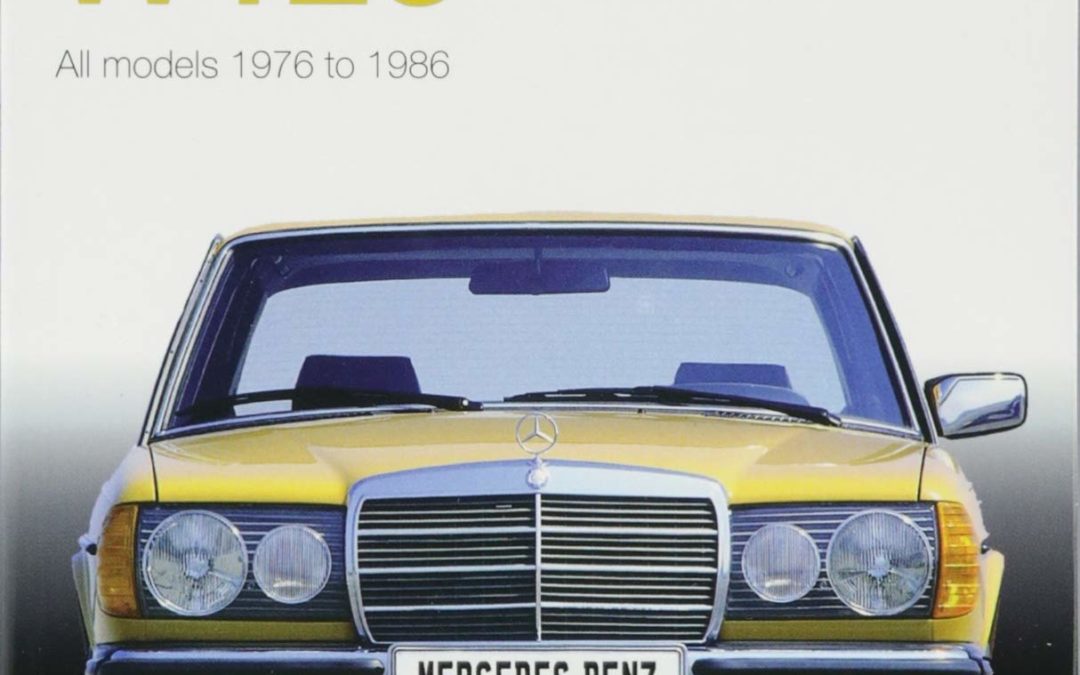
With nearly 2.7 million cars produced, Mercedes’ W123 series was hugely successful. As well as the practical saloon (sedan), Mercedes offered a stylish coupe and a roomy estate (wagon), which was built in-house for the first time. Often considered the marque’s best-engineered cars of all time, they are increasingly sought after as modern classics, yet many are still suitable to drive every day. From the taxi ranks of Germany to the dusty roads of North Africa, many of these cars have led a hard life, and examples in good condition are becoming ever more difficult to find.
This guide will help you learn about the differences between models, and what to look for when buying. What are the true running costs, and what issues – with the mechanicals, body or interior – should you be wary of? Is a restoration worth considering?
This handy guide will take you step-by-step through the process of finding and evaluating a good W123 and making a successful purchase. Essential data and information about clubs and specialists will help you look after and enjoy your W123 today.
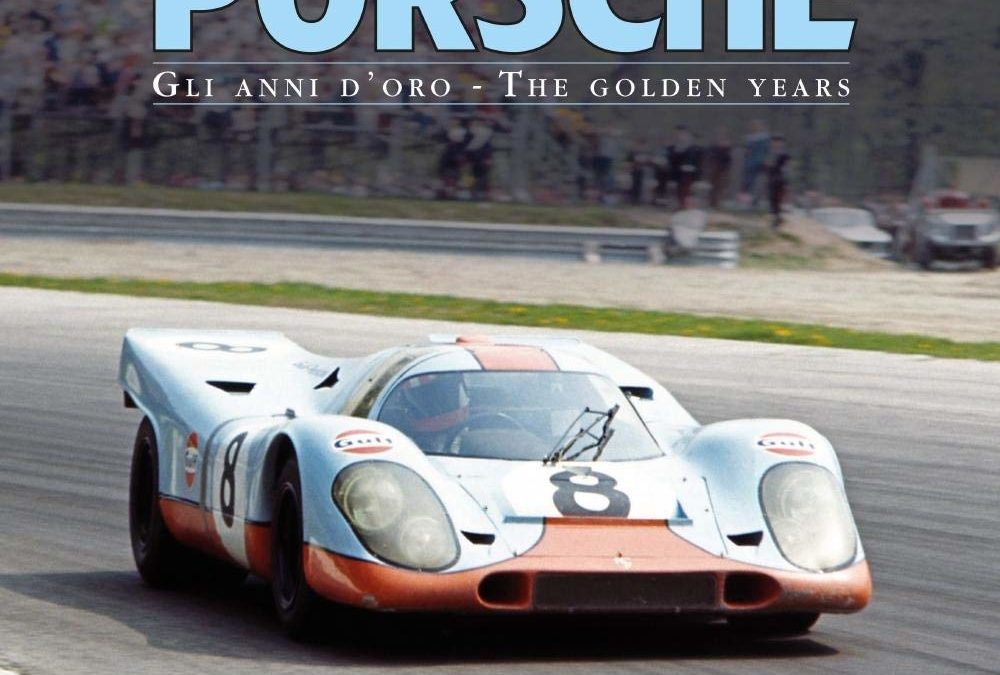
Iconic cars such as the 356s and the immortal 911s, extraordinary success stories in the classic endurance races, great champions and remarkable engineers. These are the principal ingredients of Porsche: The Golden Years, a book examining the full history of the legendary Stuttgart firm, with spectacular and previously unpublished images by photographer Franco Villani. The Porsche 356, with both closed and open bodywork, was the model that in 1948 officially inaugurated the catalogue of the celebrated Stuttgart firm. In that difficult period of reconstruction, Dr. Ferdinand Porsche, artificer of the car and founder of the marque, was already an undisputed authority in the automotive field for having designed the Volkswagen Beetle, the people’s car. The Porsche 356s were “legitimate offspring” of the Beetle and soon found favour with the public: they were sporting cars that were easy to use in everyday life. This is the true Porsche “DNA”, confirmed with the launch of the 901, or rather the 911 that first saw the light of day in 1963, a model that soon became a planetary success story, a car capable of traversing the decades while maintaining intact its appeal. The Porsche name also evokes the innumerable victories obtained in legendary endurance races such as the Le Mans 24 Hours and the Targa Florio, in the World Rally Championship and in the great African raids such as the Paris-Dakar, as well as in Formula 1 as an engine supplier to McLaren in the early ‘80s.






















